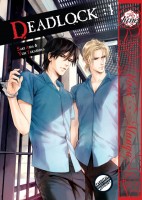My News and Reviews
Another week, another few posts at Experiments in Manga. First up was my most recent manga giveaway. Tell me about your favorite mecha manga (if you have one) for a chance to win the first volume of Mohiro Kito’s Bokurano: Ours. (The winner will be announced on Wednesday, so there’s still time to send in comments!) The first in-depth manga review of August went to In Clothes Called Fat, the most recent manga by Moyoco Anno to have been released in English. I honestly believe it to be one of the best comics of the year. (Well, at least out of those that I’ve read so far.) I also posted July’s Bookshelf Overload over the weekend for those of you who are interested in the manga that I purchase or otherwise receive over the course of a month.
Elsewhere online, Sparkler Monthly is celebrating its first year of publication by offering a free sampler download that includes the first chapter of all of its series—prose, comics, and audio dramas. Deb Aoki has a nice overview of some of the manga happenings at this years San Diego Comic Con over at Publishers Weekly. Jamie Coville has also posted audio for some of the SDCC panels, including a few focusing on manga. (Actually, there are a ton of manga related files on that page from past comic events, too.)
August 1 was 801 Day (aka Yaoi or Boys’ Love Day), and though probably not technically related the most recent Manga Studies column at Comics Forum focused boys’ love research in Japan. (Did you know that Guin Saga‘s Kurimoto Kaoru was also a BL author, editor, and scholar? Now you do!) There have been a few new Fujojocast episodes posted recently, including one specifically for 801 Day. I found episode seven, Give what’s due to Saezuru, which talks about translation, adaptation, and frustrations over publishers’ quality and quality control to be especially interesting. SuBLime made a “new” license announcement—it has gained the digital rights to couple of series that were previously print-only. The announcement is particularly noteworthy because it seems to indicate that SuBLime was able to do this because the Japanese publishers are beginning to trust that fans won’t abuse digital downloads.
Quick Takes
 Cowboy Bebop, Volumes 1-3 written by Hajime Yatate and illustrated by Yutaka Nanten. Of the two Cowboy Bebop manga that were released (Cowboy Bebop: Shooting Star being the other), Nanten’s series is the one that is most similar to the anime. This makes a fair amount of sense considering that both the anime and the Cowboy Bebop manga were written by the same group of creators, whereas Shooting Star was really its own thing. The Cowboy Bebop manga is closer in tone to the anime’s more humorous episodes, though there is some seriousness as well. The overarching plot dealing with Spike’s feud with Vicious is largely missing, however the other character’s backstories are all filled in a little bit more. The manga, like the much of the anime, is generally episodic. Most of the stories wouldn’t have been too out-of-place with the anime itself, though for the most part I didn’t find them to be as strong as their televised counterparts. The manga will likely appeal most to those who have seen the anime and would like a chance to spend some additional time with the characters; the manga feels like bonus material and deleted scenes rather than anything substantial.
Cowboy Bebop, Volumes 1-3 written by Hajime Yatate and illustrated by Yutaka Nanten. Of the two Cowboy Bebop manga that were released (Cowboy Bebop: Shooting Star being the other), Nanten’s series is the one that is most similar to the anime. This makes a fair amount of sense considering that both the anime and the Cowboy Bebop manga were written by the same group of creators, whereas Shooting Star was really its own thing. The Cowboy Bebop manga is closer in tone to the anime’s more humorous episodes, though there is some seriousness as well. The overarching plot dealing with Spike’s feud with Vicious is largely missing, however the other character’s backstories are all filled in a little bit more. The manga, like the much of the anime, is generally episodic. Most of the stories wouldn’t have been too out-of-place with the anime itself, though for the most part I didn’t find them to be as strong as their televised counterparts. The manga will likely appeal most to those who have seen the anime and would like a chance to spend some additional time with the characters; the manga feels like bonus material and deleted scenes rather than anything substantial.
 Deadlock, Volume 1 written by Saki Aida and illustrated by Yuh Takashina. Though technically a boys’ love series, not much has happened in the way of romance after the first volume of Deadlock. However, there is a good deal of plot to be found, and I think that it’s a more interesting manga because of that. Yuto Lennix is a drug investigator who was framed for the murder of his best friend and partner. Incarcerated in the Californian state prison system, he has been given the chance to reduce his sentence by helping the FBI to determine the identity of terrorist leader who is believed to be a fellow inmate. That of course is assuming he doesn’t get himself killed first. It’s a somewhat idealized version of prison—everyone is very good-looking for one—but the portrayal of the racial tensions within the system is surprisingly realistic and generally avoids using stereotypes. So far, Deadlock has a fairly large cast. The social dynamics between the prisoners are a very important part of the manga as Yuto learns his place in the hierarchy while he carries out his investigation. Deadlock is currently an ongoing series; I sincerely hope that future volumes will be licensed when they’re released as well.
Deadlock, Volume 1 written by Saki Aida and illustrated by Yuh Takashina. Though technically a boys’ love series, not much has happened in the way of romance after the first volume of Deadlock. However, there is a good deal of plot to be found, and I think that it’s a more interesting manga because of that. Yuto Lennix is a drug investigator who was framed for the murder of his best friend and partner. Incarcerated in the Californian state prison system, he has been given the chance to reduce his sentence by helping the FBI to determine the identity of terrorist leader who is believed to be a fellow inmate. That of course is assuming he doesn’t get himself killed first. It’s a somewhat idealized version of prison—everyone is very good-looking for one—but the portrayal of the racial tensions within the system is surprisingly realistic and generally avoids using stereotypes. So far, Deadlock has a fairly large cast. The social dynamics between the prisoners are a very important part of the manga as Yuto learns his place in the hierarchy while he carries out his investigation. Deadlock is currently an ongoing series; I sincerely hope that future volumes will be licensed when they’re released as well.
 Madara, Volumes 1-5 written by Eiji Otsuka and illustrated by Shou Tajima. Apparently, Madara was one of CMX’s debut manga. I’ve been discovering some fantastic series from CMX. Sadly, Madara is not one of them. I initially became interested in the series because the creators are also responsible for the extraordinarily dark and graphic MPD-Psycho. The premise of Madara also appealed to me—a young man prophesied to be king fighting demons to restore the body that his father tried to destroy—but that’s probably because it’s so similar to Osamu Tezuka’s Dororo. Except that Dororo is actually good. Madara comes across as a fairly generic sword-and-sorcery RPG more than anything else. (The series actually did go on to inspire several video games, and even an anime.) It also seems as though Otsuka and Tajima are just making things up as they go. There’s not much of an ending, either. Small glimmers of Tajima’s stunning art style (which I love) can be seen, especially towards the end of the series, but the illustrations in Madara are tragically lacking in comparison. Granted, it is a much earlier series. Here’s a fun fact about Madara, though: the series was created in a left-to-right format.
Madara, Volumes 1-5 written by Eiji Otsuka and illustrated by Shou Tajima. Apparently, Madara was one of CMX’s debut manga. I’ve been discovering some fantastic series from CMX. Sadly, Madara is not one of them. I initially became interested in the series because the creators are also responsible for the extraordinarily dark and graphic MPD-Psycho. The premise of Madara also appealed to me—a young man prophesied to be king fighting demons to restore the body that his father tried to destroy—but that’s probably because it’s so similar to Osamu Tezuka’s Dororo. Except that Dororo is actually good. Madara comes across as a fairly generic sword-and-sorcery RPG more than anything else. (The series actually did go on to inspire several video games, and even an anime.) It also seems as though Otsuka and Tajima are just making things up as they go. There’s not much of an ending, either. Small glimmers of Tajima’s stunning art style (which I love) can be seen, especially towards the end of the series, but the illustrations in Madara are tragically lacking in comparison. Granted, it is a much earlier series. Here’s a fun fact about Madara, though: the series was created in a left-to-right format.
 Sonny Leads, Volume 1 written by Richard Mosdell and illustrated by Genshi Kamobayashi. Sonny Leads holds a black belt in karate but he’s unsatisfied with his progress and so has come to Japan to further his training. Unfortunately, he doesn’t know as much as he thinks he does, and he’s in for a bit of a culture shock, too. Both Mosdell and Kamobayashi are karateka and instructors. Their knowledge of and passion for karate definitely comes through in Sonny Leads. I especially like Kamobayashi’s artwork. Particular attention is given to the proper and realistic presentation of karate forms and stances as well as to more subtle details like the appearance of the knuckles developed and used for punches and strikes. As with most of Manga University’s publications, there’s also a strong educational element present in Sonny Leads—it’s possible to learn a bit of Japanese language and culture while reading it. A very interesting essay about high school karate clubs as well as a directory to the various karate organizations in Japan are also included in the volume. I’m not sure that Sonny Leads will have much general appeal, but as a karateka myself I’d be curious to see more of the series.
Sonny Leads, Volume 1 written by Richard Mosdell and illustrated by Genshi Kamobayashi. Sonny Leads holds a black belt in karate but he’s unsatisfied with his progress and so has come to Japan to further his training. Unfortunately, he doesn’t know as much as he thinks he does, and he’s in for a bit of a culture shock, too. Both Mosdell and Kamobayashi are karateka and instructors. Their knowledge of and passion for karate definitely comes through in Sonny Leads. I especially like Kamobayashi’s artwork. Particular attention is given to the proper and realistic presentation of karate forms and stances as well as to more subtle details like the appearance of the knuckles developed and used for punches and strikes. As with most of Manga University’s publications, there’s also a strong educational element present in Sonny Leads—it’s possible to learn a bit of Japanese language and culture while reading it. A very interesting essay about high school karate clubs as well as a directory to the various karate organizations in Japan are also included in the volume. I’m not sure that Sonny Leads will have much general appeal, but as a karateka myself I’d be curious to see more of the series.













